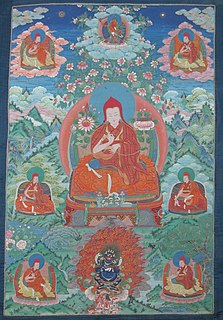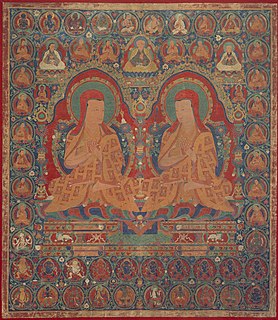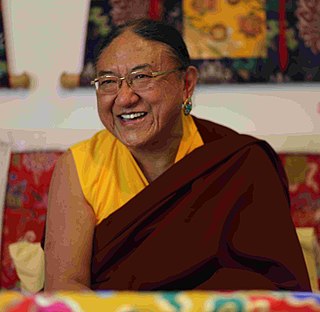
Padmasambhava, also known as Guru Rinpoche and the Lotus from Oḍḍiyāna, was a tantric Buddhist Vajra master from India who may have taught Vajrayana in Tibet. According to some early Tibetan sources like the Testament of Ba, he came to Tibet in the 8th century and helped construct Samye Monastery, the first Buddhist monastery in Tibet. However, little is known about the actual historical figure other than his ties to Vajrayana and Indian Buddhism.

The Sakya school is one of four major schools of Tibetan Buddhism, the others being the Nyingma, Kagyu, and Gelug. It is one of the Red Hat Orders along with the Nyingma and Kagyu.

Jamyang Khyentse Wangpo, also known by his tertön title, Pema Ösel Dongak Lingpa, was a renowned teacher, scholar and tertön of 19th-century Tibet. He was a leading figure in the Rimé movement.

Sonam Tsemo, an important Tibetan sprititual leader and Buddhist scholar, was the second of the so-called Five Venerable Supreme Sakya Masters of Tibet, the founding fathers of the Sakya tradition.

Sakya PanditaKunga Gyeltsen was a Tibetan spiritual leader and Buddhist scholar and the fourth of the Five Sakya Forefathers. Künga Gyeltsen is generally known simply as Sakya Pandita, a title given to him in recognition of his scholarly achievements and knowledge of Sanskrit. He is held in the tradition to have been an emanation of Manjusri, the embodiment of the wisdom of all the Buddhas.

Sakya Monastery, also known as Pel Sakya is a Buddhist monastery situated in Sa'gya Town (ས་སྐྱ་), Sa'gya County, about 127 km west of Shigatse in Tibet Autonomous Region.

Sakya Trizin is the traditional title of the head of the Sakya school of Tibetan Buddhism.

Ngor or Ngor Éwam Chöden is the name of a monastery in the Ü-Tsang province of Tibet about 20 kilometres (12 mi) southwest of Shigatse and is the Sakya school's second most important gompa. It is the main temple of the large Ngor school of Vajrayana Buddhism, which represents eighty-five percent of the Sakya school.

Wangdu Nyingpo, Tuchen was a Patriarch of the Khon Family, the 29th Sakya Trizin, and the second Padmasambhava of this age.
Lamdré is a meditative system in Tibetan Buddhism rooted in the view that the result of its practice is contained within the path. The name "lamdré" means the “path" with its fruit Wylie: ‘bras). In Tibet, the lamdré teachings are considered the summum bonum of the Sakya school.

Phagmo Drupa Dorje Gyalpo [1110-1170], was one of the three main disciples of Gampopa Sonam Rinchen who established the Dagpo Kagyu school of Tibetan Buddhism; and a disciple of Sachen Kunga Nyingpo [1092-1158] one of the founders of the Sakya school of Tibetan Buddhism. He was the elder brother of Kathog Dampa Deshek [1122-1192], who founded Kathog monastery and the Kathog branch of the Nyingma school.

Jigdal Dagchen Sakya Rinpoche was a Tibetan Buddhist teacher educated in the Sakya sect. He was educated to be the head of the Sakya school of Tibetan Buddhism as well as the successor to the throne of Sakya, the third most important political position in Tibet in early times. Dagchen Rinpoche was in the twenty-sixth generation of the Sakya-Khön lineage descended from Khön Könchok Gyalpo and was regarded as an embodiment of Manjushri as well as the rebirth of a Sakya Lama from the Ngor sub-school, Ewam Luding Khenchen Gyase Chökyi Nyima.
Ngor is a sub-sect of the Sakya tradition of Tibetan Buddhism. The main monastery of the Ngor sect is the Ngor monastery of Evam Choden about 20 kilometres (12 mi) southwest of Xigazê.

Ratna Vajra Rinpoche, is a Tibetan Buddhist teacher and the 42nd Sakya Trizin, considered one of the highest qualified lineage masters of both the esoteric and exoteric traditions of Buddhist philosophy and meditation. He is a descendant of the famous Khon family in Tibet, which holds an unbroken lineage of great and famous masters for over a thousand years. He is the eldest son of the 41st Sakya Trizin Ngawang Kunga. He teaches Buddhism and travels extensively throughout Europe, Asia, Australia, New Zealand and North America. Ratna Vajra was enthroned as the head of the Sakya school on 9 March 2017. On 16 March 2022, the throne of the Sakya school was passed by Ratna Vajra to his younger brother Gyana Vajra, who became the 43rd Sakya Trizin.
Jetsunma Chime Tenpai Nyima was a Tibetan Buddhist master, the only female master of the Sakya Vajrayoginī lineage. She is also considered a great siddha and an emanation of Vajrayoginī. She was born in Tibet and originally had the name Chime Butri. She was part of the prominent Sakya Khon family, which established itself by the 11th century in Sakya, Tibet. She studied with her uncle Kunga Lodro, who had had a vision prophesying, among other things, that she would be one of the closest disciples who would carry on his teachings. He transmitted to her the core Sakya Lamdre and the Vajrayogini teachings, among others. In 1782, she took novice vows from the twenty-fifth abbot of the Sakya Lhakhang Chenmo, Jampa Chokyi Tashi, who gave her the ordination name by which she has come to be known, Chime Tenpai Nyima.
Jetsun Pema Trinle (1874-1950) was a Tibetan Buddhist teacher, and was one of only a few women authorized to teach the general and esoteric presentation of the Path and Result in the Sakya tradition, known as Lamdre Tsokshe and Lobshe respectively. As a child she received teachings from her paternal great-aunt Jetsunma Tamdrin Wangmo, her elder brother, her father Kunga Nyingpo Sampel Norbu, and the abbot of Ngor, Ngawang Lodro Nyingpo. She rarely gave public teachings. She did tour eastern Tibet to give and receive teachings, and her main teacher there was Tenpai Wangchuk, who himself was a disciple of her great-aunt Tamdrin Wangmo. She also received Lamdre teachings from Jamyang Loter Wangpo, and gave teachings to the 3rd Dezhung Rinpoche.
Khön Könchok Gyalpo was the founder of the Sakya School of Tibetan Buddhism, and the founder of Sakya Monastery. Khön Könchok Gyalpo was born in Sa'gya, Tsang. He was a member of the Khön family, and his ancestry can be traced back to Khön Dorje Rinpoche, student of Padmasambhava. He followed his father and brother and learned doctrines of the Nyingma School at a young age, but studied newly translated Vajrayāna texts with Drogmi Shakya Yeshe later. Khön Könchok Gyalpo established Sakya Monastery in 1073, where the Sakya Tradition first developed. His son Khön Kunga Nyingpo was regarded as the first leader of Sakya, and Khön Könchok Gyalpo is known as the first Sakya Trizin.

Sakya Trizin Ngawang Kunga served as the 41st Sakya Trizin, the throne holder of the Sakya Lineage of Tibetan Buddhism, from his appointment in 1952 until his retirement in 2017. His religious name is Ngawang Kunga Tegchen Palbar Trinley Samphel Wangyi Gyalpo. After passing the throne of the Sakya lineage to his elder son Ratna Vajra Rinpoche who became the 42nd Sakya Trizin on 9 March 2017, he is now known as Kyabgon Gongma Trichen Rinpoche. He is considered second only to the Dalai Lama, in the spiritual hierarchy of Tibetan Buddhism.
The Phagmo Drupa Kagyu or Phagdru Kagyu (ཕག་གྲུ་བཀའ་བརྒྱུད) is a subschool of the Tibetan Kagyu school.
Khön clan of Sakya is a Tibetan clan and nobility originally based in Sa'gya. The clan traces its history to the time of Bod Chen Po. The Sakya Trizin of Sakya school was exclusively chosen from members of this clan. The current head of Khön clan is Gyana Vajra Rinpoche.














